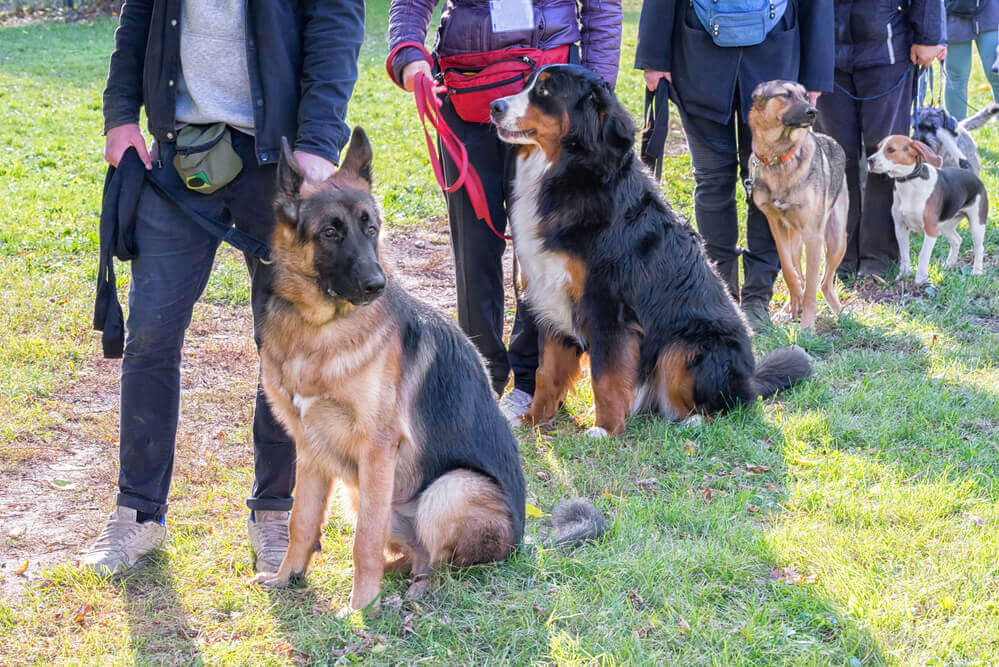Deciding to volunteer with your dog as a therapy team is a commendable tribute. After all, therapy dogs help brighten so many people’s days while also providing them with a beneficial calming effect.
Luckily, getting your dog therapy dog certification is relatively easy. This is especially true if your dog is well trained, socialized, and has a calm and friendly disposition.
Here I will be explaining exactly what you need to do to make your dog a therapy dog. Please note that this advice is for therapy dog certification within the United States, so you will need to do additional research if you live in another country.
What are Therapy Dogs and What Makes Them so Great?

Therapy dogs work to improve the emotional well-being of those around them. While the therapy dog may only be around a person for a relatively short amount of time, this experience tends to have lasting positive impacts on a person.
When most people think of therapy dogs, they picture a dog visiting people in hospitals and nursing homes. There is a very good reason for this. Most individuals in these facilities are going through a lot of emotional stress. After all, hearing bad news about poor health or the passing of a friend or loved one is an incredibly emotional time in someone’s life.
Studies have shown that bringing therapy dogs into these environments has lasting positive impacts on the emotional well-being of their patients and residents. This positive impact sometimes improves an individual’s overall health as well. Schools have also seen that therapy dogs benefit a child’s learning, especially for children with special needs. This has led to more therapy dogs entering classrooms.
Top Tip: While any breed can potentially become a therapy dog, certain breeds may have specific requirements or restrictions. For example, you may be wondering if an American Bully can be trained to be a service dog. You can find out more about this topic in our article “Can an American Bully Be a Service Dog?”
How To Train Your Dog To Be a Therapy Dog
Luckily, it is pretty easy to make dogs with solid temperaments therapy dogs. All you need is some extra training, certification, and practice.
Here is a step-by-step guide on making your dog a therapy dog.
1. Teaching Basic Commands
The first step in preparing your dog to be a therapy dog is teaching them basic commands.
All therapy dogs must be well trained. This helps the handler of the dog stay in control while volunteering, and it also keeps the dog and those around them safe.
Here are some of the commands that every therapy dog needs to know:
- Sit
- Lie Down
- Leave It
- Stay
- Come (Recall)
- Focus (Look at You)
- Heel and Walking With a Loose Leash
There are some other commands that may be beneficial for therapy dogs, but not absolutely necessary. Commands like Up (to climb up onto something), Drop It, and Rest (to lay their head in someone’s lap) are great examples.
2. Socialization for Therapy Dogs
Therapy dogs must also be incredibly well-socialized. This is because therapy dogs must be calm yet confident in every given situation.
Socializing your therapy dog with other animals, a variety of environments, situations and stimuli, and people of all ages and appearances is a crucial in the therapy dog training plan.
Additionally, it is a good idea to socialize your therapy dog with things like medical equipment, wheelchairs, walkers, and canes. This is because it is extremely likely that your therapy dog will be around these things in the future. It is best to start this process as early as possible.

3. Temperament Testing for Therapy Dog Candidates
Temperament testing is used to assess a dog’s suitability for therapy work.
Therapy dogs must be friendly, calm, and totally non-reactive. This includes not reacting to loud sounds, falling objects, people, or other animals.
They must also be tolerant of things like rough handling and petting. This is because many children, elderly individuals, and those with mobility problems may pet a dog roughly by accident.
A temperament test will evaluate your dog to ensure that they tick all of these boxes. It is recommended that you temperament test your dog before you start therapy dog training classes.
4. Training Classes for Preparing Your Dog to be a Therapy Dog
There are many great therapy dog training classes designed to prepare you and your dog for therapy dog certification.
You can find some great therapy dog programs through the AKC with the Canine Good Citizen class and test. This is a great precursor for therapy dog certification.
Petco offers therapy dog training classes that focus on developing the skills and temperament required for therapy work, and also covers basic obedience and socialization. The AKC Canine Good Citizen Test is offered through Petco as part of the Therapy Dog Certification process
To help your dog become a confident and effective therapy dog, Petsmart also offers a 6-week therapy dog training course at $169. The course covers the fundamentals of therapy work, such as behavior modification and certification preparation.
There are many dog trainers and dog training centers that offer canine good citizen classes for between $100 and $150 for a 6 week course.

5. Practice Makes Perfect: Preparing Your Dog for Therapy Work
Practice always makes perfect, especially with the extensive dog training needed for therapy dogs.
Continue practicing training and socializing your dog to new things including helping your dog feel confident and relaxed in therapy settings.
6. Certifying Your Dog as a Therapy Dog
There are many different types of therapy dog certification, and they can vary in price greatly. According to the AKC, passing your Canine Good Citizens test is all you need to start therapy work. Once your dog has done some volunteering, they can then receive further therapy dog certification.
The cost of certification for both CGC and therapy dog titles is around $40 and must be done through the AKC.
7. Volunteering as a Therapy Dog Team
Once your dog has received their CGC certification, all you need to do is find a place to volunteer.
Volunteering is a great way to gain practical experience and make a positive impact in your community as a therapy dog team.
You can contact nursing homes, hospitals, and schools to see if they are accepting therapy dogs as volunteers.
Once you have found a volunteer location, set up a time and date for your first session. You can slowly increase the length and frequency of your visits over time as you gain reputability and your dog gets more used to the work.

8. Ongoing Education for Therapy Dog Teams
It is always a good idea to stay up-to-date on current training methods and recommendations for therapy dogs. This is even after you have been volunteering for a while. Staying up-to-date will help keep you knowledgeable and savvy about the therapy dog world.
You can do this through official therapy dog workshops, seminars, and even just speaking with other therapy dog trainers and handlers.
Next Read: Difference Between Service Dog and Emotional Support Dog


